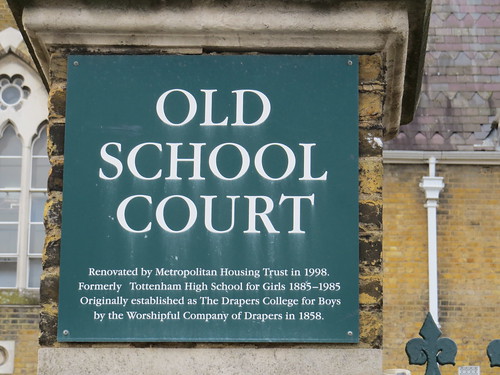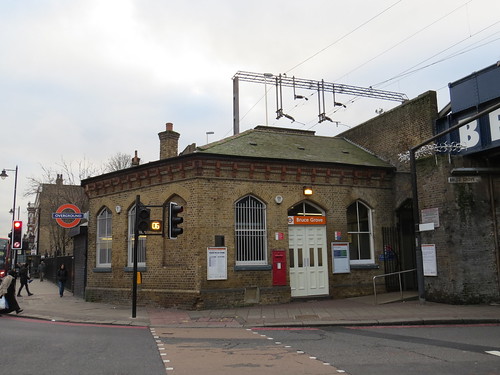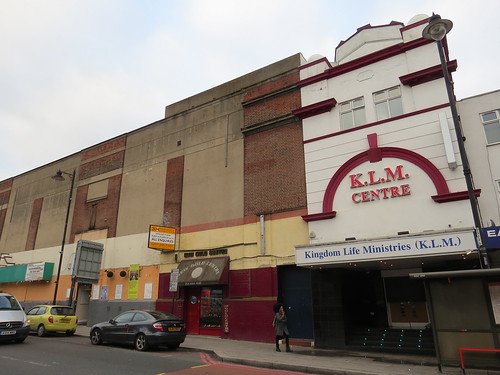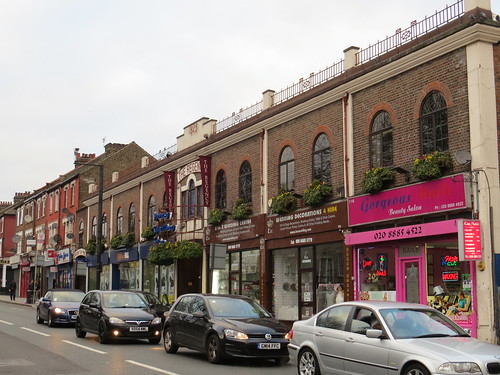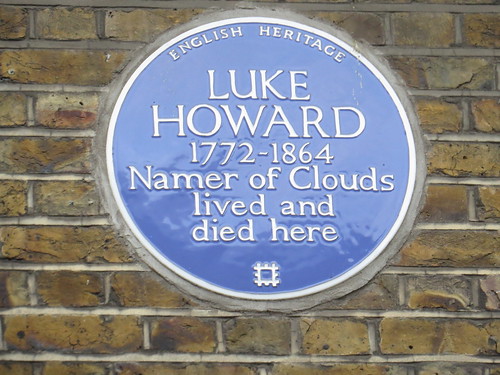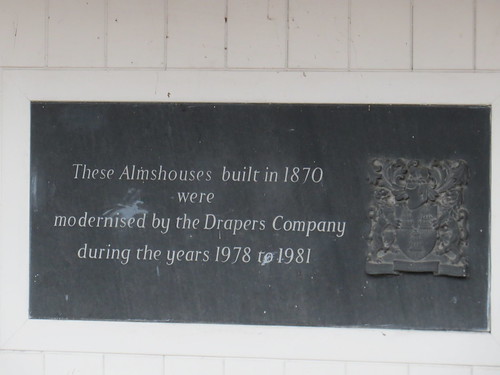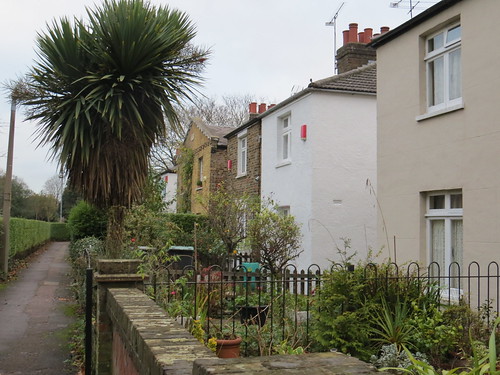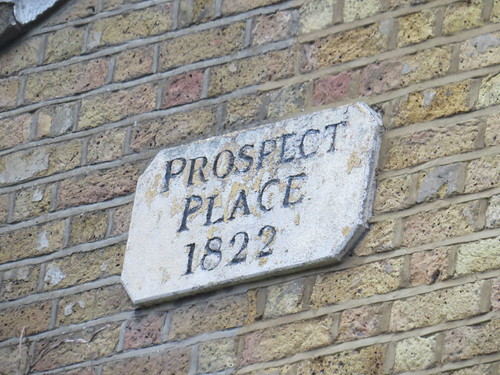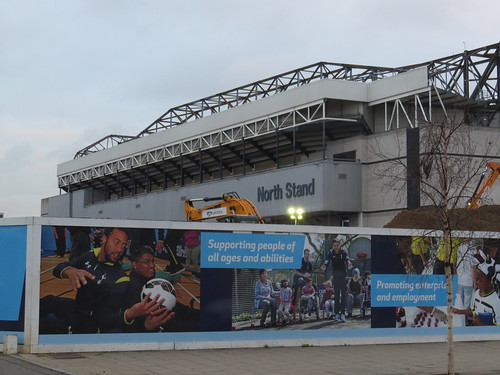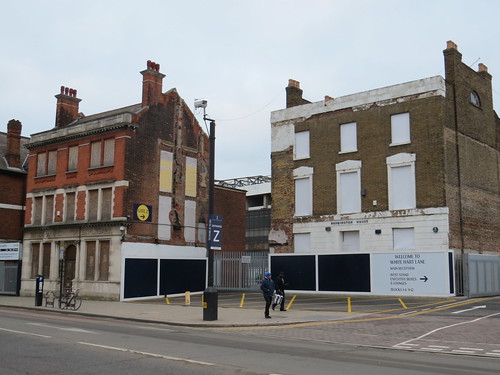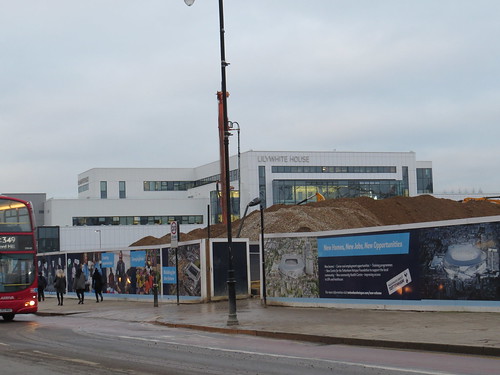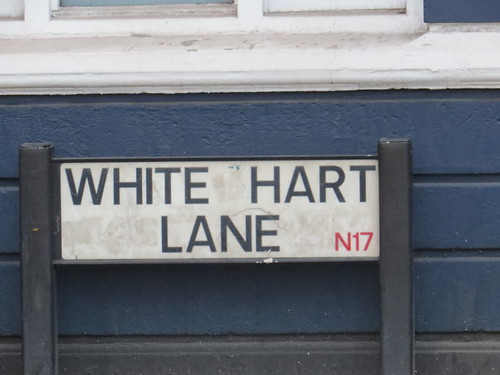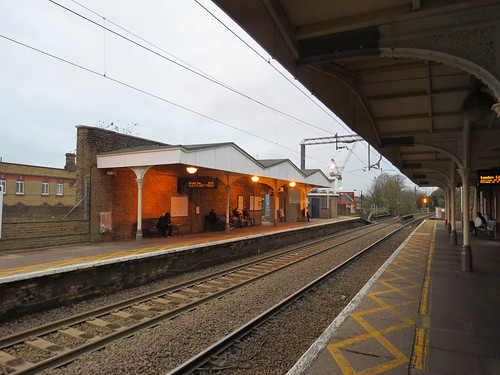N17 is Tottenham proper as opposed to South Tottenham, or Seven Sisters which we saw in N15. And of course Tottenham is forever associated with Tottenham Hotspur Football team.
We start our walk at the Bruce Grove Post Office at 476 High Road, N17 9JF.
Turn left out of the Post Office and continue along the High Road past the Police Station. Our first couple of stops are just opposite the Police Station
Stop 1: Former Palace Theatre, 421 – 427 High Road
This building looks like an old theatre and indeed it is. This was built as the Palace Theatre of Varieties, which opened on 31 August 1908. And the date can be seen in the ironwork on some of the doors. If you look carefully, you can see “19” in the middle of the left panel and “08” on the right.
For the first few years, it was presenting a mix of variety and drama but in 1922 it began showing films in the afternoons some days a week. From November 1924 it became a full time cinema, renamed the Canadian Cinema.
According to the wonderful Cinema Treasures site, it would most likely be at this period of time that the projection box was built on the rear of the stage and this theatre remained a back-projection cinema for the rest of its life – a somewhat unusual arrangement. The reason for this was there was no room available in the rear of the dress circle and one in the rear of the balcony would have given too steep an angle and a keystone effect on the screen.
It became the Palace Theatre once again in January 1926 and was taken over by the Gaumont British Theatres in 1929. Gaumont merged with Odeon later and they became part of the Rank Organisation. Rank closed the Palace Theatre on 28 June 1969. It does not seem to have been renamed either Gaumont or Odeon at any time.
The building was converted into a Bingo Club, initially operated by Mecca and later by the smaller chain of Jasmine Bingo Clubs. The Jasmine Bingo Club closed in February 1996. The building became a church initially called the Palace Cathedral, but now is something else.
Our next stop is literally next door.
Stop 2: site of Royal Ballroom, 415 – 419 High Road
This modern building was once the location of the Royal Ballroom.
The first entertainment building here was a roller skating rink which opened in February 1910. Clearly the roller skating craze quickly waned because the building was soon redesigned opening as the Canadian Rink Cinema in June 1911. By 1925 it had closed as a cinema, possibly due to the adjacent Palace Theatre converting to full time cinema use (and taking the name Canadian Cinema for a while – see above).
According to Cinema Treasures, the Canadian Rink Cinema was converted into a dance hall known as the Tottenham Palais and became a well known North London nightspot for several decades. Later owned by Mecca, by the 1960s it was known as the Tottenham Royal and in later years became the Temple nightclub. It was demolished in 2004 and this modern building is now on the site, leaving no trace of the fact this was once a place of entertainment.
Walk a little further along the High Road and turn right into Drapers Road. Our next stop is ahead beyond the gates.
Stop 3: Old School Court
Today this is called Old School Court.
But as the sign explains this was built as Drapers College.
The sign says it was established by the Worshipful Company of Drapers in 1858, but architectural historian Pevsner dates the building to 1860- 1862. It was Tottenham High School for Girls from 1885 to 1985 and the building were converted to residential use in 1996.
Return to the main road and back towards where you started.
This is by the way the old Roman road Ermine Street which comes out of the City at Bishopsgate and heads north to Lincoln and York. Ermine Street is an old English name, as no one knows what the Romans called the road. But it has nothing to do with the fur Ermine but rather derives from the name of a tribe called Ernigas whose territory the road ran through in Hertfordshire and Cambridgeshire.
Soon on the left you will see the main road (A10) takes a left turn under a railway bridge, the line of the old roman road carries straight on. Our next stop is here at this junction.
Stop 4: Bruce Grove station
Although Bruce Grove station seems to be better preserved than Stoke Newington, it too has had its staircases denuded of their roofs. I do think this looks horrible but no doubt it is cheaper to maintain.
But if you go up to the platform, their canopies seems to have survived in their original form, including their wooden fascia boards.
However according to Wikipedia all is not what it seems. In the early 1980s several changes were made to the appearance of the station, apart from the staircases. The London bound platform roof was shortened and the waiting rooms boarded up. The North-bound roof opposite (which was identical) was completely removed and a small brick shelter was installed in its place. This shelter lasted for nearly twenty years before it was itself demolished and a new roof, built in the style of the original though much shorter, was constructed giving the illusion of original authenticity to the station. Haringey Council funded this work and the station is considered a site of historic interest in the locality.
Return to the street and turn left under the railway. Our next stop is just ahead on the right.
Stop 5: former Bruce Grove Cinema, 117 Bruce Grove
Here we have another old cinema.
The cinema here first opened in July 1921 and was operated by a local independent company, Tottenham Cinema and Entertainment Co. Ltd, according to the Cinema Treasures site.
The building was reconstructed in August and September 1933. Externally it was modernised and the original domed tower feature was removed. The auditorium was Art Deco style.
In 1962 the cinema was taken over the Star Cinemas Ltd of Leeds who closed it in August 1963 and converted it into a Star Bingo Club. At some time the building was spilt with the stalls area becoming a snooker club and the former balcony extended forward to the proscenium to remain a bingo club for a few more years.
Bingo upstairs closed in May 1983 and the space was empty until 1986. It was used for two short lived ventures (an indoor cricket pavilion and a “Quazar” laser shooting gallery). Then in the early 1990s it was converted into a church, known as the Freedom’s Ark. Snooker continued in the former stalls area, together with a Caribbean restaurant.
In May 2011, the Freedom’s Ark church vacated the building and moved elsewhere in Tottenham. But there seems to be a church in here again now but I am not sure what the rest of the whole building is being used for.
Our next stop is just next door
Stop 6: Former Bruce Grove Ballroom, 113 Bruce Grove
In 1923, the owners of the Bruce Grove cinema commissioned the cinema’s architect (Charles E. Blackbourn) to design a ballroom, to add to the cinema’s amenities.
It opened in 1923 as the Bruce Grove Ballroom, with the ballroom upstairs at first floor level, and shops on the ground floor.
The Star Cinemas chain seems to have acquired this at the same time as the cinema and continued to operate the ballroom until 1974, when they converted it into a four-screen cinema, opening in July 1974 as Studios 5,6,7,8 – not sure where Studios 1, 2 3 or 4 were. These operated until December 1981. The building was then empty for a couple of years until it was returned to a single space and reopened as the Regency Banqueting Suite in 1984, which is what it is today.
Now look across the road.
Stop 7: Number 7 Bruce Grove
We are stopping at Number 7 not because of the building but because of who lived here.
Luke Howard (1772 – 1864) was an amateur meteorologist. As the blue plaque delightfully says he was a namer of clouds. He was not the first to try to name clouds – a Frenchman, Jean-Baptiste Lamarck (1744–1829), beat him to it but it was in French. Howard’s system used Latin and applied the principles of natural history classification, as espoused by Carl Linnaeus. Thus Howard arrived at a workable solution to the problem of naming transitional forms in nature, like clouds.
Continue walking along Bruce Grove. Our next stop is ahead on the right.
Stop 8: Drapers Almhouses
Continue along Bruce Grove and our next stop is set back off to the right of the street. These were built in 1870 by three foundations connected to the Drapers Company.
As the sign says they were modernised during the years 1978 – 1981.
So although the Drapers do not seem to have a school in the area now, they still maintain the connection to the area with these almshouses.
Continue to the end of the road and our next stop is immediately ahead beyond the mini roundabout.
Stop 9: Bruce Castle
This is the somewhat misnamed Bruce Castle, as it is not and never has been a castle.
The name Bruce Castle is derived from the Scottish House of Bruce, who way back had owned a third of the manor of Tottenham. When Robert the Bruce became King of Scotland in 1306 he forfeited his lands in England, including the Bruce holdings in Tottenham, ending the connection between the Bruce family and the area.
The three parts of the manor of Tottenham were united in the early 15th century under the Gedeney family.
The front we see today from the road dates from a remodelling of the house in the late 17th century, but with some additions were made in the 18th century, but there may be some older bits lurking.
Bruce Castle is now a museum, holding the archives of the London Borough of Haringey, and housing a permanent exhibition on Haringey and its predecessor boroughs, plus temporary displays on the history of the area. There is also an exhibition on Rowland Hill and postal history – Rowland Hill was the instigator of the universal penny post and his connection to Bruce Castle is that he lived here in the 1840s.
It s worth a quick turn if it is open as you pass.
Behind the “castle” is a park which was the first public park in Tottenham, opening in 1892.
Now take Church Lane which the road running down the left hand side of the “castle” and park. Pass the Church and our next stop is as the road bends to the right.
Stop 10: Prospect Place
Here we have a lovely little terrace of houses dating from 1822 and called “Prospect Place”.
And this is the prospect today:
If you have time you can venture into the cemetery and see the river Moselle, one of the London almost lost rivers, which we heard about in Muswell Hill.
My fellow guide, Jen Pedler has created a walk which follows the path of the Moselle. This was first done as part of the Footprints of London River Walks festival in Spring 2015.
When walking through Tottenham which was perhaps not the most scenic part, Jen got her walkers to join in a 400 year old song, called “The Tottenham Toad”. This is about the courtship of a Tottenham lad (‘toad’), who falls for a country girl from Enfield (‘squirrel’), But the river Moselle keeps flooding its banks forcing him the wade through high waters to make it work.
Here are the words:
The Tottenham Toad came walking up the road,
With his feet swimming in the sea,
‘Pretty little squirrel with her tail in a curl,
They’ve all got a wife, but me.’
I married me a wife to join my life,
She soon wished I were dead.
In about six weeks we had a little quarrel
And she pulled all the hair out of my head.
Sadly I do not have Jen and her walkers singing this. But here are two local schools (Noel Park and St Francis De Sales) with their version (which does not exactly follow the above words).
http://www.ariver-runsthroughit.org.uk/events/singing-tottenham-toad-bruce-castle
Continue along the road (which is Church Road) and at the end you will be back at the High Road.
Stop 11: Tottenham Hotspur (“Spurs”) Football Ground (White Hart Lane)
You cannot really miss our next stop as it looms up over the main road.
Known as White Hart Lane, the curious thing about it is that the ground is not actually in White Hart Lane.
Tottenham Hotspur Football Club can trace their origins back to 1882 and they started playing at this site in 1899. The name “Hotspur” is said to be is a reference to Henry Percy, whose descendants owned land in the neighbourhood of the club’s first ground in the Tottenham Marshes. Henry Percy is remembered largely because he is a character in William Shakespeare’s Henry IV, Part 1. Percy is killed by his rival (and the future King), Prince Hal. Henry Percy was also known as Harry Hotspur as he wore riding spurs and his fighting cocks were fitted with spurs. The latter can be seen in the crest used by the Football Club.
Today the ground is undergoing a multi-million pound rebuild.
In the past the club did consider relocation. Back in 2001, there was the idea of relocation to a proposed 43,000-seat stadium at Pickett’s Lock. This would have been built for the 2005 World Athletics Championships. However the games went elsewhere and so the stadium was never built. Other possible relocation included the new Wembley Stadium and the 2012 Olympic stadium. In 2013 the latter stadium became the subject of fierce competition between Spurs and West Ham United. West Ham won although the decision was initially challenged by Tottenham Hotspur.
At the same time as the Olympic Park bid, and instead of relocating, the Club was pursuing via its Northumberland Development Project a plan to build a new stadium, partly on the site of the existing White Hart Lane ground. The new stadium has a planned capacity for 61,000 spectators.
Now we let’s go down the actual White Hart Lane which is a side street on the other side of the High Road from the actual stadium.
Our final stop is a little way down White Hart Lane.
Stop 12: White Hart Lane station
This is the closest station to the Football Ground. It has a modern building at ground level, denuded staircases and some canopies on the platforms, although these are not so well preserved as the ones at Bruce Grove, having lost the original decorative fascias.
It is interesting to see how three stations (Stoke Newington, Bruce Grove and White Hart Lane, all built at the same time (1872) and in the same style, have fared in the modern world. All of them have been disfigured. Bruce Grove seems to have come out best even though it is not all original.
Well that brings us to the end of our N17 walk. – several places of entertainment, connections with a City Livery Company, a major football club … and the namer of clouds. And we are at a station which has a reasonable train service (usually every 15 minute) for onward travel.





